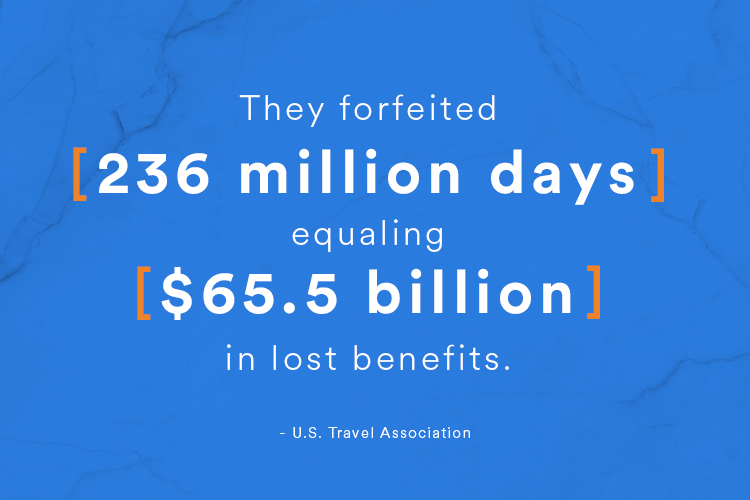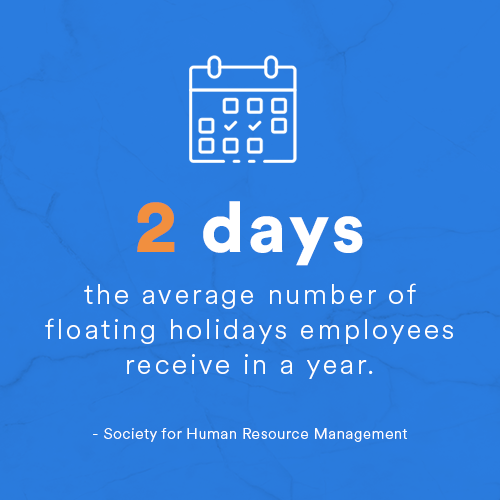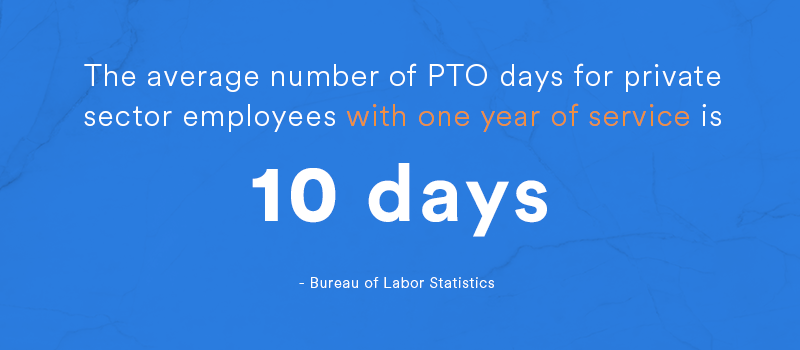If you’ve ever had a day off, you know how awesome they are. It is a simple and true joy to not have to go in to work when you would normally have to and spend a day however you want. Sometimes that’s to go on vacation, other times to recuperate from an illness, or literally anything else besides work. So, it makes sense to have a paid time off (PTO) policy in place for your employees, right?
Work-life balance is of the utmost importance to employees and job seekers alike; increasingly it is as important as their paychecks. Employees want to be able to work, family, health and hobbies with greater ease. But what’s even more? Offering PTO isn’t just good for your employees, but also for your business.
How your PTO policy can save you money
Saving your employees from burnout via PTO saves you, the business owner, money. How? Unscheduled absences are expensive. To the tune of $225 billion annually in the U.S. or $1,685 per employee in productivity losses, according to the CDC. When someone is out unexpectedly, coworkers or managers must pick up the slack, sometimes hiring replacement workers when things get dire.
Not to mention, not taking time off affects your employees physical and mental health, which directly impacts their attitude, engagement and productivity at work. It’s better for your employees to have the ability to take off time when they need it and all of it. PTO can also make your employees feel valued, which is important to developing trust and job satisfaction.


Encourage your employees to take time off work. If upon an employee leaving, that’s extra money out of your pocket. And it’s bad for the employees. They should consider PTO as an extension of their salary, like a currency. They wouldn’t leave money on the table for a job, they shouldn’t forfeit unused days off either.
Popular types of PTO policies
But now that we’ve (hopefully, fingers crossed) convinced you to offer a PTO policy, what kind of policy is best? Well, like many questions, that depends on you and your employee population. So, we’ll review three of the most popular PTO models and discuss pros and cons for each type.
Encourage your employees to take time off work. If upon an employee leaving, that’s extra money out of your pocket. And it’s bad for the employees. They should consider PTO as an extension of their salary, like a currency. They wouldn’t leave money on the table for a job, they shouldn’t forfeit unused days off either.
Popular types of PTO policies
But now that we’ve (hopefully, fingers crossed) convinced you to offer a PTO policy, what kind of policy is best? Well, like many questions, that depends on you and your employee population. So, we’ll review three of the most popular PTO models and discuss pros and cons for each type.
Floating PTO holidays
 Floating holidays are days that can be offered as an alternative to a public holiday. Your employees can choose to exchange a public holiday (like MLK day) for another day of their choice. Often, floating holidays are a supplement to a PTO policy and are a great way to allow for more flexibility. They accommodate cultural and religious diversity. For example, if some of your employees do not celebrate the Christmas holiday, they can choose to work that day and take a day off at another time.
Floating holidays are days that can be offered as an alternative to a public holiday. Your employees can choose to exchange a public holiday (like MLK day) for another day of their choice. Often, floating holidays are a supplement to a PTO policy and are a great way to allow for more flexibility. They accommodate cultural and religious diversity. For example, if some of your employees do not celebrate the Christmas holiday, they can choose to work that day and take a day off at another time.
This way, employees do not have to take multiple days off to do the things that are important to them. It’s up to you how you structure the use of their PTO days. Do you have “black out dates” when employees cannot take off because it’ a busy season? Can they carry their floating holidays over form year to year? Do you pay them out if an employee quits or at the end of the year? Do they accrue them or have a set amount to be used? Lots of questions to ask and answer based on your employees.
Unlimited PTO
Offering unlimited PTO is a more recent trend to hit employers. Essentially, employees do not institute a set number or limit of days employees can take throughout the year. That’s not to mean employees can take off whenever they want. Employees must still get their work done and managers must approve time off. This requires a certain level of trust between employer and employee but can be mutually beneficial. First, unlimited PTO can be a great recruiting tool for employers. Employees feel valued when they can be trusted and have the flexibility to use days at their discretion. This display of trust improves engagement and therefore productivity and can lower turnover. Additionally, when you aren’t paying out unused vacation days at the end of the year or at the end of employment, you are saving money.
Of course, there is a fear of employees abusing the policy, so it depends on your employees and whether they are responsible and whether you have the infrastructure in place to hold people accountable to the policies you implement.
PTO bank
Offering a PTO bank is also common among employers. Essentially, you don’t differentiate between sick or vacation leave. Employees get a “bank” of days during the year and can withdraw them however they want. This certainly gives employees a sense of privacy because they do not have to tell employers why they are using their days, and control because they can use them how and when they want. That’s an empowering tactic and can improve your relationship with your employees and increase their job satisfaction.
A larger issue with this specific model is legislation that requires employers in certain states or localities to distinguish between sick leave and vacation leave. There is no federal law as of yet that requires employers to offer sick leave, but you should be aware of what laws you are subject to. You also have to determine are how many days or hours you are going to allot during a year and how those times are accrued.
If you are transitioning to a PTO bank model, employees may feel like they are using vacation time to go to the doctor because time is not separate. Some may be less likely to use days when they are sick, even though they have them available. It is recommended that you communicated the importance of using PTO days to your employees.
Floating PTO holidays

Floating holidays are days that can be offered as an alternative to a public holiday. Your employees can choose to exchange a public holiday (like MLK day) for another day of their choice. Often, floating holidays are a supplement to a PTO policy and are a great way to allow for more flexibility. They accommodate cultural and religious diversity. For example, if some of your employees do not celebrate the Christmas holiday, they can choose to work that day and take a day off at another time.
This way, employees do not have to take multiple days off to do the things that are important to them. It’s up to you how you structure the use of their PTO days. Do you have “black out dates” when employees cannot take off because it’ a busy season? Can they carry their floating holidays over form year to year? Do you pay them out if an employee quits or at the end of the year? Do they accrue them or have a set amount to be used? Lots of questions to ask and answer based on your employees.
Unlimited PTO
Offering unlimited PTO is a more recent trend to hit employers. Essentially, employees do not institute a set number or limit of days employees can take throughout the year. That’s not to mean employees can take off whenever they want. Employees must still get their work done and managers must approve time off. This requires a certain level of trust between employer and employee but can be mutually beneficial. First, unlimited PTO can be a great recruiting tool for employers. Employees feel valued when they can be trusted and have the flexibility to use days at their discretion. This display of trust improves engagement and therefore productivity and can lower turnover. Additionally, when you aren’t paying out unused vacation days at the end of the year or at the end of employment, you are saving money.
Of course, there is a fear of employees abusing the policy, so it depends on your employees and whether they are responsible and whether you have the infrastructure in place to hold people accountable to the policies you implement.
PTO bank
Offering a PTO bank is also common among employers. Essentially, you don’t differentiate between sick or vacation leave. Employees get a “bank” of days during the year and can withdraw them however they want. This certainly gives employees a sense of privacy because they do not have to tell employers why they are using their days, and control because they can use them how and when they want. That’s an empowering tactic and can improve your relationship with your employees and increase their job satisfaction.
A larger issue with this specific model is legislation that requires employers in certain states or localities to distinguish between sick leave and vacation leave. There is no federal law as of yet that requires employers to offer sick leave, but you should be aware of what laws you are subject to. You also have to determine are how many days or hours you are going to allot during a year and how those times are accrued.
If you are transitioning to a PTO bank model, employees may feel like they are using vacation time to go to the doctor because time is not separate. Some may be less likely to use days when they are sick, even though they have them available. It is recommended that you communicated the importance of using PTO days to your employees.

Pro tips:
- If your employees are important to you and taking time off is valued, then it should be supported on all levels – executives, managers and fellow employees. So long as employees are getting their work done and abiding by the policies you set, they shouldn’t be punished or guilt-tripped for taking time off.
- Everyone needs guidelines or some form of limitations. Set PTO policy expectations from the beginning. Ensure employees understand them completely so they know how they can use their benefits. This is especially true for those with unlimited PTO policies.